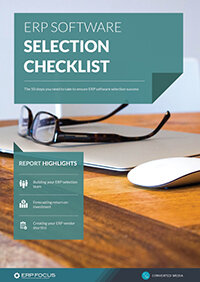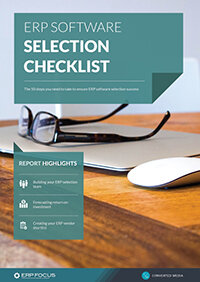A six-step timeline for your ERP selection
Defining an ERP selection timeline can be either a very basic or very complex process, but either way the effort is usually guided by the needs of the enterprise itself. Even leveraging a single-module decision can consume as much as two quarter’s worth of effort in some extreme cases.
However, if your business decides to move toward more than just a single ERP module, a company’s ERP selection timeline can extend forward into years before a final decision is entirely sussed out. In this guide we use a mid-point of selection complexity in order to offer you a sense of how the middle-ground appears from an ‘average’ schedule perspective.
Prudence, detail and patience
Before any useful timeline can be established a company must begin to define a set of business requirements. Elements associated with this effort typically involve any business process that interacts within one or more projected ERP modules. For example, when defining the initial scope of a finance-based operational requirement, the end-game usually looks like this:
Finance - This module encompasses several elements associated with general bookkeeping, AR, AP and Payroll.
However, while this sentence suggests a straightforward proposition, the statement’s ‘when and how long’ elements can go sideways quickly. When it comes to a selection project schedule, a manager has to be ready to apply equal parts prudence, detail and patience.
Consequently, an applied ERP selection timeline overview would typically include the following elements:
1. Culture (weeks 1-4)
The first step in an ERP selection project is to clearly understand the enterprise’s overall needs, i.e. what drives the company’s rationale for efficiency? Are enterprise operations driven by production and sales, or is the company marketing, advertising and/or admin-heavy? Each company’s culture leans one way or the other, and a solid set of requirements usually flows from the culture up, not the other way around.
Recommended Reading: ERP Selection Checklist - Get the complete selection checklist in one download
From a project scheduling perspective, I usually consume four week’s worth of project time in order to talk to necessary internal constituents including senior and horizontal management peers (two weeks), plus canvassing representative groups of line staff (one week), plus a week’s worth of margin.
2. Type (weeks 5-6)
Once you understand enterprise culture, compare those value points with today’s constellation of ERP products in order to define a set of general commonalities between processes and the way a company values itself. For example, fairly simple ERP systems like Intuit’s QuickBooks are primarily oriented to simplicity, cost-efficiency, and speed of implementation, rather than complexity derived by deep data delivery. So, if one’s company is long on administrative, marketing and advertising rather than production statistics, Intuit or similar variant should work for you. However, if the inverse holds true an SAP, Plex, Oracle etc. would announce themselves accordingly. Executing this comparison is usually done by the decision maker internally, and this kind of subjective thinking usually consumes no more than two project weeks.
3. Hard requirements (weeks 7-18)
Now that you understand ‘how’ your company behaves, and have created a general list of ‘why’ product candidates may apply, the real work begins.
As suggested earlier, this process is a deep drilling effort since a good set of requirements establishes ‘what’ a product is supposed to do, but also sets the company up for what can be expected from an early cost and implementation schedule perspective. In this scenario, I usually allow for two weeks per sub-element, plus a week’s worth of tweaking, in addition to a week’s worth of time creating, publishing and distributing a final requirements document. Bearing all this in mind, this section of your ERP selection timeline should be pencilled in for twelve weeks end-to-end at minimum.
4. Selection (weeks 19-20)
Once the ERP project manager has a set of requirements, they will apply the company’s operational criteria against available product variants, leading to a shortlist of options. If the manager has been forward-leaning throughout the requirement process, many ERP candidates can be pre-validated to a large degree. However, at minimum this process usually takes two weeks worth of project time.
5. Consideration (weeks 21-24)
With requirements and the shortlist in the hands of the enterprise, they will come under consideration from all departments. Scheduling a consideration round within an ERP selection timeline is highly subjective and driven entirely by the vagaries and limitations of daily operations. That said, to get all of the right people looking at a common requirement and considering a product list usually takes two-weeks worth of deliberation, and another two-weeks to refine the shortlist.
6. Demo and final purchase (weeks 25-29)
Once a manager has a vetted shortlist in hand, it’s time to schedule a talk with one or more product providers, followed by a practical demo. Again, scheduling this element relies upon available time, since the enterprise is often not able to control its own schedule. However, providers typically want to get to a meeting sooner rather than latter, so on average the time between an initial telephone request and a demo is usually two weeks, followed by another two weeks to get a final purchase.
In a nutshell, then, our ERP selection timeline has consumed 29 project weeks just to get the system identified, selected and purchased; the implementation schedule is yet to come.
Free white paper

60-Step ERP Selection Checklist
Get the comprehensive checklist for your ERP selection project

Featured white papers
-

ERP Software Pricing Guide
Get the latest pricing information on over 80 popular ERP systems, and learn how to budget for your ERP project in our free guide
Download -

60-Step ERP Selection Checklist
Get the comprehensive checklist for your ERP selection project
Download -

ERP Demo Guide & Scorecard
Master your ERP demo with 5 easy steps using our free guide (includes demo scorecard)
Download
Related articles
-

The best ERP systems for process manufacturing
Consider these ERP systems when selecting your next process manufacturing ERP
-

Secret KPI: Why Your ERP Implementation Team Matters More Than Software
Learn how Godlan ensures successful ERP implementation for manufacturers with proven strategies &...
-

5 ERP pricing definitions you need to understand
Have you mastered the ERP pricing lexicon yet? Getting to grips with these five definitions is a ...

